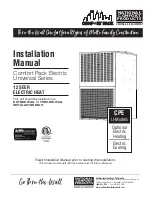
5.3.19 357-00016-01 Rev A © Inovonics, 2019 - www.inovonics.com
EH4104R Single Zone Fire RF Receiver with
Relays
Installation Instructions
1 Overview
The EH4104R single zone fire RF receiver with relays is designed for use
with the Inovonics EH1115EOL EchoStream single input fire RF transmitter
to monitor water flow and pressure in piping and post indicator valves to
send an alert when a fire protection system has been activated.
The EH4104R single zone fire RF receiver with relays allows you to add a
transmitter to any application. With diversity reception and advanced signal
processing, Inovonics EchoStream technology is designed to minimize
dead spots in transmission areas.
1.1 Installing an Inovonics System
An EchoStream survey kit should be used to establish an EchoStream
system. The EchoStream survey kit measures the signal strength of high-
power repeater and sensor messages to help optimize your EchoStream
system.
Note:
For more information about the EchoStream survey kit, see the
EN7017 Survey Kit and App Installation and Site Survey Instructions.
Caution:
The EchoStream system should be tested regularly to ensure
operation. To test: place the system in test mode, activate an end device,
and ensure an appropriate response.
1.2 RF Signal Propagation
While wood, drywall and glass usually let the RF signals pass, some
materials may inhibit or attenuate radio frequency (RF) signal propagation
by blocking, reflecting, deflecting or absorbing RF signals.
Consider anything between transmitter and the receiver. Is there concrete
and steel construction? Are there earthen berms or hills? Are there a lot of
trees? The device should be mounted such that it is least affected by these
elements.
For best results, the transmitter should be mounted at the optimal height to
achieve line of sight to the receiver. Usually this means it will be mounted
as high as possible.
Following are some typical obstacles to RF signal propagation:
1.3 Inovonics Wireless Contact Information
If you have any problems with this procedure, contact Inovonics Wireless
technical services:
• E-mail: [email protected].
• Phone: (800) 782-2709; (303) 939-9336.
1.4 EH4104R Front Panel
Figure 1
EH4104R receiver LEDs and buttons
A
RF initiating device alarm LED
B
RF initiating device tamper LED
C
RF initiating device low battery LED
D
RF initiating device inactive LED
E
Power LED
F
RF initiating device number LEDs
G
Review button
1.5 EH4104R LEDs
Normal Operating Mode
Review Mode
Press and release button on the EH4104R front cover. Review mode times
out after ten seconds.
Material
Affect
Recommendation
Metal construction,
including ductwork;
pipes; studs; stucco,
plaster or concrete with
wire mesh; satellite
dishes, metal-lined
rooms such as walk-in
coolers or freezers;
metal siding, safes, etc.
Can reflect,
absorb and/or
disrupt RF
signals.
Perform a site survey
using an Inovonics
wireless survey kit to
verify the RF signal is
acceptable.
Completely enclosed
metal boxes/enclosures.
Can restrict RF
signals.
Solar panels, cinder
block walls, windows
with built-in solar tinting.
Can absorb and/
or reflect RF
signals.
Vegetation.
Can attenuate
RF signals. The
RF environment
can alter as
trees shed or
sprout leaves.
Automobile and truck
traffic.
Can disrupt RF
signals.
Mount Inovonics
devices at a height
sufficient to achieve
line of sight above
traffic.
LED
Event
Relay
Alarm and 1
Alarm activation.
Relay 1 is on until the
condition clears.
Tamper
Initiating device case
tamper or EOL resistor
trouble.
Relay 5 is latched on
until EH4104R is reset.
Battery
Initiating device low
battery warning.
Relay 5 is latched on
until EH4104R is reset.
Inactive
Initiating device not heard
for more than three
minutes.
Relay 5 is on until the
condition clears.
Decode
Valid message was received. Decode LED is visible
only with the cover removed.
LED
Description
Alarm and 1
Last message from initiating device indicated alarm.
Tamper and 1
Last message from initiating device indicated tamper.
Material
Affect
Recommendation
A
B
D
E
F
G
C























